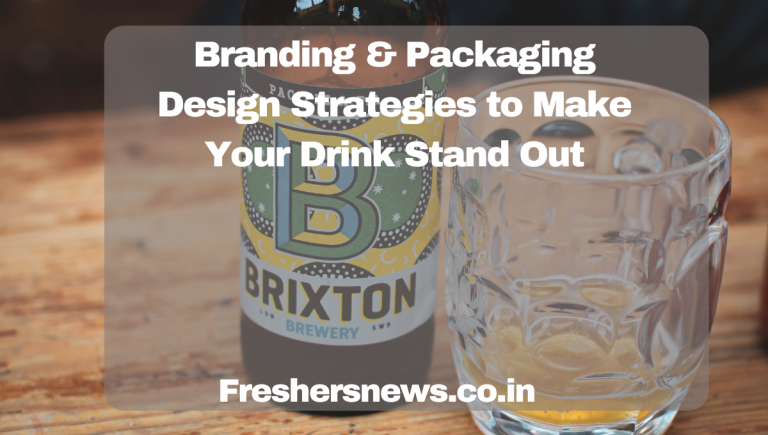In the fiercely competitive beverage industry, establishing a strong brand identity and creating eye-catching packaging designs are essential for capturing consumer attention, building brand recognition, and driving sales. Effective branding and packaging design strategies can differentiate products on crowded shelves, convey brand values, and evoke emotional connections with consumers. In this comprehensive guide, we will explore key branding and packaging design strategies that beverage companies can leverage to make their drinks stand out in the market and resonate with target audiences.
Crafting a Compelling Brand Identity
Developing a compelling brand identity is the foundation of successful branding efforts in the beverage industry. It involves defining the brand’s unique personality, values, and positioning in the market to create a memorable and authentic brand experience for consumers. Entrepreneurs must conduct market research to understand consumer preferences, competitor positioning, and market trends, allowing them to identify opportunities for differentiation and innovation.
Once the brand identity is established, entrepreneurs can create brand assets such as logos, color schemes, and typography that reflect the brand’s personality and resonate with the target audience. Consistency across all brand touchpoints, including packaging, marketing materials, and digital channels, is crucial for reinforcing brand identity and building brand equity over time. By crafting a compelling brand narrative and visual identity, beverage companies can effectively communicate their unique value proposition and establish a strong emotional connection with consumers.
Designing Eye-Catching Packaging
Packaging design plays a critical role in influencing consumer purchasing decisions and conveying brand messaging on retail shelves. Eye-catching packaging designs can capture consumer attention, communicate product attributes, and evoke positive associations with the brand. When designing beverage packaging, entrepreneurs must consider factors such as functionality, shelf appeal, and brand consistency to create a cohesive and memorable brand experience.
Innovative packaging materials, shapes, and finishes can help beverages stand out in crowded retail environments and differentiate themselves from competitors. Additionally, incorporating visual elements such as vibrant colors, bold typography, and engaging imagery can attract consumers’ attention and communicate key brand messages effectively. By investing in professional packaging design services and conducting consumer testing, beverage companies can ensure that their packaging designs resonate with target audiences and drive purchase intent.
Leveraging Storytelling and Brand Messaging
Effective storytelling and brand messaging are powerful tools for connecting with consumers on an emotional level and creating brand loyalty. Beverage companies can leverage storytelling techniques to convey their brand’s heritage, values, and commitment to quality, fostering a deeper connection with consumers beyond product features and benefits. By crafting authentic and relatable brand narratives, entrepreneurs can humanize their brands and build trust with consumers.
Incorporating brand messaging into packaging design elements such as product labels, taglines, and product descriptions can further reinforce brand identity and communicate key brand attributes. Clear and concise messaging that highlights product features, benefits, and unique selling propositions can help consumers make informed purchasing decisions and differentiate the brand from competitors. By weaving storytelling into packaging design and brand messaging, beverage companies can create memorable brand experiences that resonate with consumers long after the initial purchase.
Embracing Sustainability and Eco-Friendly Packaging
With growing consumer awareness of environmental issues, sustainability has become a significant factor in packaging design and brand perception. Beverage companies can demonstrate their commitment to sustainability by adopting eco-friendly packaging materials, reducing packaging waste, and implementing sustainable manufacturing practices. Sustainable beverage packaging solutions such as biodegradable materials, compostable packaging, and recycled content can appeal to environmentally conscious consumers and align with their values.
In addition to reducing environmental impact, embracing sustainability can also enhance brand reputation and differentiate products in the market. Beverage companies can leverage sustainability initiatives as a point of differentiation and competitive advantage, attracting environmentally conscious consumers and fostering brand loyalty. By prioritizing sustainability in packaging design and manufacturing processes, beverage companies can contribute to environmental conservation efforts while building a positive brand image and driving consumer engagement.
Adapting to Consumer Trends and Preferences
Consumer preferences and market trends are constantly evolving, requiring beverage companies to stay agile and adaptable in their branding and packaging strategies. Keeping abreast of emerging trends such as health and wellness, clean labeling, and functional ingredients allows companies to anticipate consumer needs and tailor their branding and packaging accordingly. By leveraging consumer insights and market research, beverage companies can identify opportunities for innovation and develop products that resonate with evolving consumer preferences.
Moreover, beverage companies must be proactive in responding to changing consumer behaviors and market dynamics, such as the rise of e-commerce and the demand for convenience packaging solutions. Embracing digital technologies, personalization strategies, and omnichannel marketing approaches can help companies engage with consumers across multiple touchpoints and drive brand awareness and loyalty. By staying attuned to consumer trends and preferences, beverage companies can position themselves for long-term success and capitalize on emerging opportunities in the dynamic beverage market landscape.
Conclusion
Effective branding and packaging design are essential components of a successful beverage marketing strategy, enabling companies to differentiate their products, connect with consumers, and drive sales. By crafting compelling brand identities, designing eye-catching packaging, leveraging storytelling techniques, embracing sustainability, and adapting to consumer trends, beverage companies can create memorable brand experiences that resonate with target audiences and foster brand loyalty. As the beverage industry continues to evolve, entrepreneurs and marketers must remain vigilant and innovative in their branding and packaging efforts to stay ahead of the competition and capitalize on emerging opportunities in the market.


